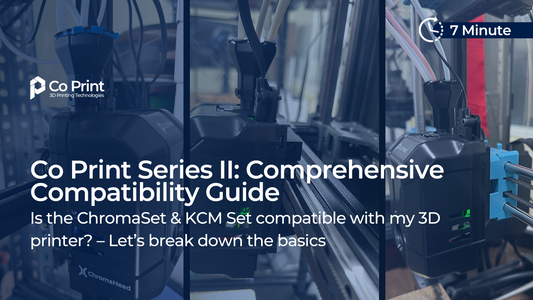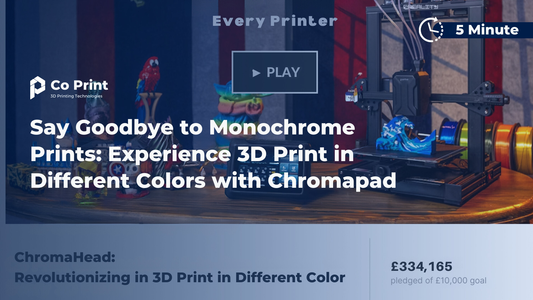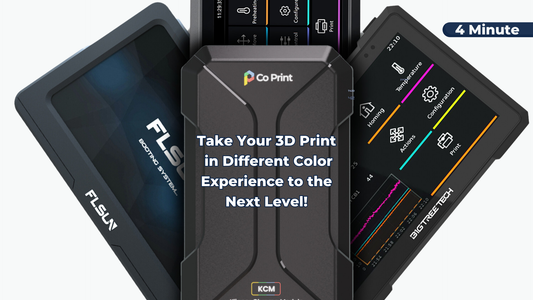As the use of technology in education rapidly spreads, 3D printers are bringing an innovative approach to teaching methods. Moving beyond traditional methods, they allow students to turn abstract ideas into tangible objects, enhance their creativity, and explore the knowledge they have learned through hands-on experiences. In this article, we will present various examples of how 3D printers can be used in education and show how this technology is transforming students' learning experiences. We will explore creative and practical applications that benefit both teachers and students.
Benefits of 3D Printers in Education
3D printers offer a great opportunity in education to turn abstract concepts into tangible ones. Instead of learning based solely on theoretical knowledge, students can solidify what they have learned by creating 3D models, making the learning process more accessible. For example, in science lessons, a student can directly observe the structure of atoms or cells through a 3D printer, allowing them to grasp theoretical information as a real object. Mathematical concepts can similarly be made concrete. Students can experience geometric shapes and volume calculations through 3D models. These types of materializations help make the knowledge more permanent in students' minds. Additionally, working with tangible materials boosts students' creativity and makes learning more interactive. 3D printers enable learning to become an active process, allowing students not only to receive information but also to learn by turning that information into tangible forms.
Successful 3D Printer Applications and Project Examples
We have listed free examples in fields such as science, social studies, and mathematics. You can access the 3D models for each example via the provided links.
Science
This project demonstrates the impact of river erosion on the Grand Canyon. Students can simulate a terrain model and water source using 3D printable files. In the experiment, made with PLA and PVA, they will observe how the canyon forms as the water erodes the PVA.
This 3D animal cell model helps students better understand the organelles and structure of the cell. With Co Print technology, you can create colorful prints that make each organelle stand out, making it easier for students to distinguish these structures.
Printing a model of the Solar System with a 3D printer allows students to visualize the movements and positions of the planets, enabling them to learn more effectively. The sun, at the center of the model, is designed to rotate with all the planets revolving around it, and a gear mechanism simulates the planets' movements relative to each other at the correct scale. By printing each planet in color using Co Print technology, students can easily distinguish between the planets.
The 3D water cycle model visualizes the movement of water in nature, making teaching more tangible. Stages such as evaporation, condensation, and precipitation are highlighted with colorful prints, allowing each stage to be easily distinguished.
The skull model shows the five main parts of the human skull in detail. The model allows you to print each part separately and in color, making it easier for students to understand the structure of the skull and how the pieces fit together.
The frog dissection kit provides students with the opportunity to learn basic anatomy without the challenges of dissecting a real frog. The kit includes digital files for printing a large-sized frog body and six 3D printed organ pieces that fit together.
The topographic model of Mount Everest visualizes the mountain's structure and elevation differences. With 3D printing, it becomes possible to explore the area from the summit to the foothills in detail. By using Co Print technology for multicolored printing, students can more easily understand the mountain's natural structure and elevation variations.
This anatomical model is designed based on medical references, accurately depicting each bone in its unique shape, arranged to interconnect and form the complete skeleton. With this model, you can provide a realistic examination experience, making learning more effective.
Mathematics
This activity allows students to create number sentences using blocks. Each block represents a specific number or symbol, and students can arrange these blocks to form mathematical expressions or simple numerical sentences.
Base-10 number blocks are a tool to help students learn place value. By visualizing different values such as ones, tens, hundreds, and thousands, they make it easier for students to understand the structure of numbers. These blocks present numbers in a tangible way, making learning mathematical concepts more fun and effective for children.
This toy allows children to develop basic math skills such as addition, subtraction, multiplication, and division through an interactive game. By matching numbers and using a spinning mechanism, the toy helps children learn mathematical concepts in a more enjoyable way.
Tactile graphs are a great tool for helping students understand graphical data in a tangible way. Designed especially for visually impaired or low-vision students, these graphs are created using raised lines, shapes, and labels. Students can learn by feeling the changes, trends, and relationships in the graphs through touch.
Fraction blocks are an educational tool for teaching students fractions in a tangible way. These blocks consist of colorful pieces that represent different fractions, helping students understand how fractions work both visually and tactually. For example, fractions like whole, half, and quarter are displayed with blocks of various sizes, allowing students to learn fractions by combining or separating these blocks.
Social Studies
The 3D printed model of the Colosseum showcases the structure's exterior and interior in great detail. Students can easily examine the architectural features and layers of the Colosseum, allowing them to learn about historical structures in a more tangible way.
The 3D printed model of the Tikawa Ancient Ruins allows for a closer exploration of the structure and architecture of this historic site. The model visually presents the details and unique features of the ancient ruins, enabling students to gain a deeper understanding of Tikawa.
The 3D printed model of the Hammurabi Stele allows for a detailed view of one of ancient Mesopotamia's significant historical artifacts. It helps students gain more concrete knowledge about Hammurabi's Code and ancient legal systems.
This 3D printed model is a scaled representation of the ancient Temple of Artemis, one of the Seven Wonders of the Ancient World. The model visually showcases the architectural details and grand structure of the temple, helping students gain a better understanding of this historical landmark.
This 3D printing activity offers a great hands-on experience for studies on Ancient Egypt. Students can write their names in cartouche style using hieroglyphs, then print their personalized cartouches in 3D.
The 3D printed model of the map of Europe helps students better understand the continent's borders. Each country on the map can be highlighted in different colors, making it easier for students to distinguish between different regions.
Bonus
Customized medals are personalized awards designed for a special event, achievement, or celebration. These medals can be customized with names, dates, logos, or special messages. They make a great reward to boost students' motivation.
The 3D printed model of a customized medal allows students to celebrate achievements in a personalized way. Names, dates, and special messages can be added, making each medal unique and meaningful. This encourages motivation and recognition in educational settings.
The opportunities offered by 3D printers in education are truly limitless. They support visualizing abstract concepts and encourage creative thinking processes in various fields for students of all ages. 3D printers deepen students' learning experiences and provide a more effective educational process. Particularly with Co Print technology, making multicolored prints helps make learned information more understandable. With this technology, it's possible to visualize organelles in color and detail, distinguish different elevations in topographic models, or bring historical structures to life in a more tangible way. In short, 3D printers create an innovative experience in every area of education, and with Co Print, this experience becomes even richer. These creative solutions allow students to learn while having fun and reinforce their knowledge in a more lasting way.




